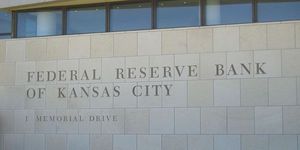Kansas City Fed Update-Ag Lending Variables and Farmland Values
 Nathan Kauffman and Ty Kreitman indicated in a recent update from the Federal Reserve Bank of Kansas City (“As Rates Tick Up, Growth in Operating Loans Boosts Farm Lending“) that, “Rounding out a year characterized by lower farm incomes, uncertainties about agricultural trade and the growth of lending volumes, interest rates on agricultural loans trended higher. The mounting combination of higher leverage and rising rates could put additional pressure on some farm operations.”
Nathan Kauffman and Ty Kreitman indicated in a recent update from the Federal Reserve Bank of Kansas City (“As Rates Tick Up, Growth in Operating Loans Boosts Farm Lending“) that, “Rounding out a year characterized by lower farm incomes, uncertainties about agricultural trade and the growth of lending volumes, interest rates on agricultural loans trended higher. The mounting combination of higher leverage and rising rates could put additional pressure on some farm operations.”
Today’s update looks at the Kansas City Fed update in more detail with a particular focus on agricultural lending variables and farmland values.
Lending Variables
The Fed report stated that, “Non-real estate lending continued to increase in the fourth quarter, according to the National Survey of Terms of Lending to Farmers. Total non-real estate farm loans were up nearly 8 percent from a year ago.”
“As Rates Tick Up, Growth in Operating Loans Boosts Farm Lending,” by Nathan Kauffman and Ty Kreitman. The Federal Reserve Bank of Kansas City (January 17, 2019).
“The increase in farm financing also continued to be driven by lending to fund current operating expenses. The volume of operating loans reached a historical high for the fourth quarter, increasing more than $10 billion, or 22 percent year over year,” the Fed report said.
“As Rates Tick Up, Growth in Operating Loans Boosts Farm Lending,” by Nathan Kauffman and Ty Kreitman. The Federal Reserve Bank of Kansas City (January 17, 2019).
Turning interest rates, Kauffman and Ty Kreitman explained that, “As the volume of farm loans continued to increase in the fourth quarter, interest rates also increased. The distribution of rates has shifted significantly in recent years, and in the fourth quarter 40 percent of all non-real estate farm loans were charged a rate more than 6 percent. At this time in 2017, a quarter of all loans were charged an interest rate less than 4 percent.”
“As Rates Tick Up, Growth in Operating Loans Boosts Farm Lending,” by Nathan Kauffman and Ty Kreitman. The Federal Reserve Bank of Kansas City (January 17, 2019).
The authors noted that,
The combination of increased lending needs and higher interest rates has continued to raise the cost of financing at a modest pace.
“For a mid-sized Midwest farm operation that has not increased its financing needs in recent years, annual interest expenses have increased just about $3 an acre. However, for operations that have required a moderate amount (10 percent per year) of additional financing, annual interest expenses have increased about $10 an acre.”
“As Rates Tick Up, Growth in Operating Loans Boosts Farm Lending,” by Nathan Kauffman and Ty Kreitman. The Federal Reserve Bank of Kansas City (January 17, 2019).
Last week’s Fed report also pointed out that, “In addition to higher rates of delinquency on farm loans, financial pressures in the agricultural sector also have led to an upward trend in farm bankruptcy filings. Since reaching a 10-year low in 2014, the number of filings has steadily increased; filings, however, remained well below highs reached in 2010.”
“As Rates Tick Up, Growth in Operating Loans Boosts Farm Lending,” by Nathan Kauffman and Ty Kreitman. The Federal Reserve Bank of Kansas City (January 17, 2019).
Farmland Values
With respect to farmland values, Kauffman and Kreitman stated that, “Despite tightening credit conditions and higher interest rates, farm real estate values generally remained stable. In fact, the value of nonirrigated farmland increased in many states in the third quarter.”
“As Rates Tick Up, Growth in Operating Loans Boosts Farm Lending,” by Nathan Kauffman and Ty Kreitman. The Federal Reserve Bank of Kansas City (January 17, 2019).
“Despite mounting pressure on the farm sector and limited profit opportunities, the value of farm real estate has continued to provide ongoing support and remains a key area to monitor in the coming months if leverage continues to increase,” the Fed report said.
Source: Keith Good, Farm Policy News






